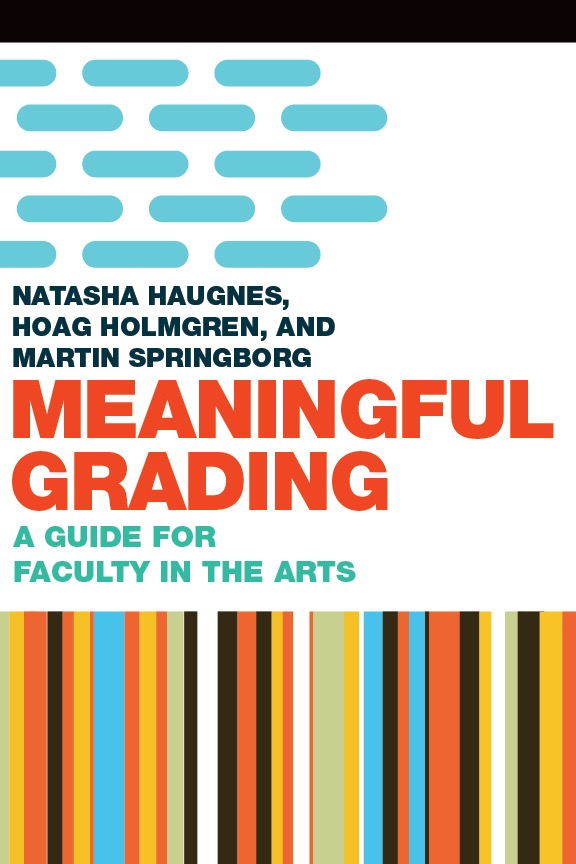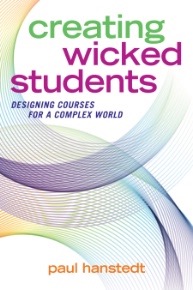course design
Select an item by clicking its checkbox

Meaningful Grading: A Guide for Faculty in the Arts
Date Reviewed: November 29, 2018
Meaningful Grading: A Guide for Faculty in the Arts provides a framework for continual improvement and deliberate practice in the area of course design, assignment creation, and assessment. Although this book focuses on faculty in the arts, its wisdom is accessible to all faculty in higher education. The authors argue that “strong teaching requires careful planning, even though the time constraints of academe do not always allow for it” (2). Therefore this book is comprised of fifty tips that can stand alone and/or work together to provide a cohesive pedagogical framework. Meaningful Grading is divided into three parts: (1) course design and preparation, (2) during the semester, and (3) post semester.
The book begins by challenging the reader to examine their own beliefs and biases, know their educational context, and define what success will look like in their course (6-7). As I read this section, I was reminded that many faculty in higher education receive little to no training in pedagogy and course design. Haugnes, Holmgren, and Springborg argue that we must be intentional in our course design and that “grading, if it is to be meaningful to students, must be intentionally integrated into the whole course” (30). The authors focus heavily on ensuring that course goals, teaching and learning activities, and assessment (evidence of success) must work together to support student learning. The course design process is iterative and one will cycle through “all the legs of the tripod multiple times. . . until each is in alignment to help support deep learning” (33).
Part two presents a series of tips that operate as “grab and go ideas in the middle of the semester” (65). This section provides advice on how to clearly communicate the goals and expectations that were crafted in part one. It also focuses on how to teach discrete skills and content as well as how to emphasize process over perfection. The authors suggest that it is important to identify what success looks like at multiple distinct points in the process in order to provide students with more meaningful feedback along the way. In addition, it is through the intentional use of field specific language in all communication with students (syllabus, critiques, meaningful feedback, and comments) that students are exposed to and are able to absorb field specific language and concepts.
Finally, part three provides advice on how to engage in reflection on a completed semester in order to establish and improve meaningful grading practices. The first tip in this section encourages faculty to seek feedback from students and faculty colleagues during and after the semester in order to become a more effective grader. Although this feedback can include end-of-semester evaluations, the instructor is encouraged to seek additional and separate forms of feedback from students about fairness of grades, use of rubrics, and other course activities. The instructor is also encouraged to return to course goals and course activities to assess if goals were met and the process of grading was useful for both the instructor and the students.
As a faculty member who is not in the arts (design, architecture, fine and visual arts, media arts, literary arts, printmaking, performance arts, etc.) but utilizes various forms of art in my lectures, course activities, and graded assignments, I found this text to be very helpful in expanding my knowledge of how to better incorporate and assess the use of art in a learning context where students may not initially see or value the ways in which art speaks to the content at hand. It also provided me a strong foundation on how to better communicate to students the ways in which what they are learning to master is a form of artistry.
This book provides practical and accessible advice on how to design and execute a course in any discipline in higher education while simultaneously speaking to the unique nature of assessment in the arts. I believe it is an important read for all faculty regardless of discipline and experience level, and trust that it will help us more critically examine our pedagogical strategies and assessment methodologies.
One of my favorite movies growing up was the The Sound of Music. I loved—and still love—the opening scene: the vast panoramic of Julie Andrews, arms outstretched, as Maria, belting at the top of her lungs: “The hills are alive with the sound of music!” Each song and ...

Creating Wicked Students: Designing Courses for a Complex World
Date Reviewed: September 6, 2018
Paul Hanstedt
Sterling, VA: Stylus Publishing, 2018 (x + 180 pages, ISBN 978-1-62036-697-4, $24.95) One might assume that a text called Creating Wicked Students would discuss types of “wicked” problems – complex social-environmental issues that cannot be solved with existing modes of inquiry and decision-making – that instructors might address through a problem-based learning approach. However, this work actually is an introduction ...
Creating Wicked Students: Designing Courses for a Complex World
Paul Hanstedt
Sterling, VA: Stylus Publishing, 2018 (x + 180 pages, ISBN 978-1-62036-697-4, $24.95)
One might assume that a text called Creating Wicked Students would discuss types of “wicked” problems – complex social-environmental issues that cannot be solved with existing modes of inquiry and decision-making – that instructors might address through a problem-based learning approach. However, this work actually is an introduction to course design most useful for beginning instructors or those redesigning their courses according to sound pedagogical principles. Situating himself against those who view higher education as solely preparing students for the workforce or transmitting content, Hanstedt emphasizes the importance of instilling a sense of authority in our students by helping them develop skills and attitudes that will empower them to make meaningful change in the world.
Hanstedt’s holistic vision of education includes attitudes and dispositions alongside skills and content mastery, and will likely resonate with instructors in religious studies and theology. Although he does not explicitly refer to our disciplines, he does offer examples, anecdotes, and insights from colleagues in a variety of fields and institutions, which is a strength of the book. He references seminal work in the scholarship of teaching and learning – including that of: George Kuh (2008, High-Impact Educational Practices, AACU); James Zull (2002, The Art of Changing the Brain, Stylus); and David Krathwohl (2002, “A revision of Bloom’s taxonomy,” Theory into Practice 41) – but does not engage with previous scholarship on wicked problems. Readers interested in learning more about pedagogical approaches to wicked problems could consult the work of the work of: Brown et al. (2010, Tackling Wicked Problems, Routledge); Carcasson (2017, “Deliberative Pedagogy as Critical Connective” in Deliberative Pedagogy, Michigan State University); or Lee (2016, “Systems Thinking,” in Resilience by Design, Springer).
This book could be useful as an introduction to course design for someone less familiar with the fundamentals, such as how to develop measurable learning outcomes, align course goals with institutional goals, nest content within higher-order goals, engage students’ prior knowledge, or incorporate applied learning. The structure of the book allows for one to follow it step-by-step as a course design manual, and it also includes recursive “intermissions” to encourage reflection along the way. In addition, his discussion of how to prompt critical thinking through multiple-choice exams offers helpful strategies for encouraging students to explain their thinking on ambiguous questions with follow-up questions that explain or justify their choice (92-98).

The Blended Course Design Workbook: A Practical Guide
Date Reviewed: July 6, 2017
For the faculty member transitioning a course from face-to-face (F2F) to an online or blended learning environment, Kathryn Linder’s workbook is a wonderful resource. After opening with a couple chapters reviewing the key components of backward course design, developing appropriate course learning objectives, and assessment, the remaining chapters provide a step-by-step guide for an instructor to convert a course from a physical to a virtual teaching space. The chapters cover a variety of topics including effective learning activities, assessment methods, creating a social presence, using and creating multimedia, and social media engagement.
Each chapter contains a short introduction to the pedagogical theory behind the topic (What Do We Know About…) followed by a series of guiding questions, worksheets, and templates for incorporating the theory into course development (A Step-by-Step Guide to…). After a summary of the key ideas, there are questions for faculty and administrators, followed by a graphic that illustrates course design steps and additions. Online resources are often noted for additional planning. An instructor or administrator is provided with all the tools and resources necessary for working through the process in a hands-on, orderly fashion.
The book’s main strength is its highly practical nature, highlighted by the ready-to-use worksheets, templates, and checklists for every step in the process. Not only does it explain the desired resources, it usually gives real-life examples of how the tool was used in a blended classroom effectively.
Another strength of this book is Linder’s ability to translate and explain technological tasks reasonably for the technophobe. Without talking down, she methodically explains technical components in understandable and achievable action steps for readers. Equally important, she recognizes that schools use different types of technology (for example, Learning Management System), and identifies the major software, programs, and platforms available, accounting for this variety in her instructions.
There is little to offer by way of criticism of the book. More than adequate appendices and glossaries complete an already copious amount of resources. The solid reference section supports the extensive research, clearly supporting the material.
Given the practical nature of this workbook and its many ready-to-copy worksheets, it is strongly recommended for faculty members transitioning a classroom course to a blended or online delivery format. Likewise, academic deans leading a group of faculty through a similar transition process will find this a one-stop resource, especially if they are able to partner with an educational technologist.
The questions and challenges concerning the teaching of Islam and race that I raised last year in “Teaching Islamic Theology through Black Lives” are no less urgent and relevant now as they were then. In that contribution, I attempted to delineate ways in which I could make important interventions on ...

